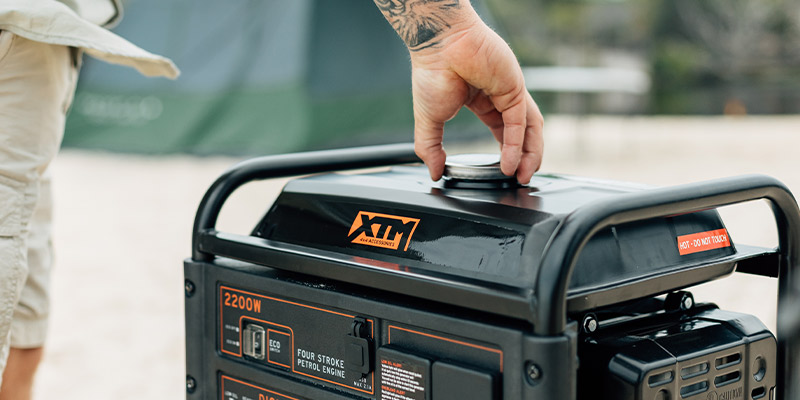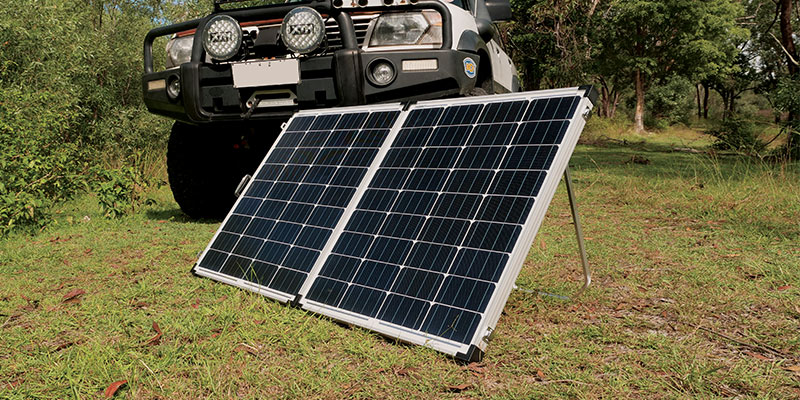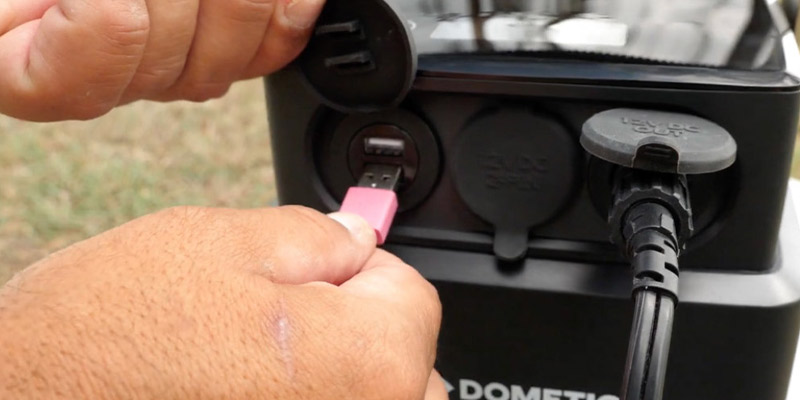As we become more reliant on technology in our everyday lives, we're finding it harder and harder to leave behind the creature comforts of home when we escape on a camping trip. Fortunately, the latest developments in portable power devices have been put to great use in ensuring we no longer need to go without. Caravanners, campers and 4WDers have all embraced the portable power option as it allows them the freedom to camp anywhere, with the peace of mind they'll have enough power for all their appliances, plus keep any phones, tablets or computers fully charged. They also make for a handy backup power supply in the event of emergencies such as blackouts, and ensure you can still have a ripper time on your next camping adventure. With such a variety of different options from generators, solar panels, battery boxes and portable battery packs, it can be tough to work out what's the right product to suit your needs. In this buyer's guide, let the BCFing experts help you in selecting the right portable power source. Chock-a-block with useful information, we'll run you through the different types of portable power, why you need them, regular power consumptions, plus some handy hints.
Why do you need a portable power source?
Designed with the purpose of making your next camping experience more enjoyable, portable power sources are a compact and quiet power alternative that can be used to charge and operate many camping appliances, while also allowing for a few of the luxuries from home. If your idea of the perfect camping trip is heading off the beaten track, or being self-sufficient at the local campground, this is the perfect addition to your camping setup. But, first, you must take into consideration a few important factors.
How often will you go camping or caravanning?
- Will it be used frequently or simply once in a blue moon? Think about how long you'll be away for. Will you be gone for a week or longer? Or will it only be used for a few nights?
Will you be close to town or completely isolated?
- If you prefer to stay close to civilisation, portable power sources are less important as you'll normally have some form of power supply close at hand, but if you're travelling further out whoop whoop, you must make sure your power supply is large enough to see you through, as assistance may be hard to come by.
What will it be used for?
- Think about the number of appliances that you'll be powering. Will it be used for your whole setup, or just a few lights, chargers etc. Make sure you have a larger capacity if it'll be powering a fridge.
How much free room is available?
- Although most portable power devices are compact in size and have a rather small footprint, it's still advised when your vehicle or caravan is being packed that you maintain enough space for each person to travel comfortably, plus any equipment or baggage you may carry.
Types of portable power sources
Whether you're hitting the local campground this weekend for a little R&R, taking the family away for the school holidays, or you're planning well in advance for the next camping trip, the addition of a portable power supply to your camping kit can enhance your experience and get your appliances ready to go next time you head bush. With such a varied selection of products all capable of keeping the power going and, more importantly, the bevvies cold, we've decided to list the different types of portable power options, their features, and the advantages of each style. This is to help you better understand which will best meet your needs and ensure your next camping adventure is a cracker.
Mains power
The benefits of staying in a powered campsite easily outweighs the added expense. With access to 240V electricity, you can feel free to enjoy all of the comforts from home without the risk of running out of power. The added purchase of power boards and extension leads allows the use of multiple devices from a greater distance.
- Plug any of your devices or appliances directly into the mains power and eliminate any chance of falling short
- Most campgrounds around Australia will have powered sites available for campers who aren't equipped with their own power supply or simply enjoy the carefree camping experience mains power provides
Generator
If glamping is more your style or you don't like to leave home without a few little luxuries, a generator could be the perfect addition to your camping kit. Whether you're a 4x4 enthusiast, caravanner, or avid camper, a portable generator is an extremely reliable item that makes light work of recharging batteries and powering devices on the go. Generators come standard with a built-in fuel tank and run on regular unleaded fuel which is readily available all around the country so you don't get caught out.

- Some generators are more economical and release less emissions, making them better for the environment
- When purchasing a generator, it's important to think about the size of the fuel tank and the efficiency of both your generator and the appliances used e.g. Will you have enough fuel to last the duration of your trip?
- Perfect for campers who like to be on the move
- Can be useful in the event of power outages or blackouts as a backup source of power
Below are some features commonly found on our range of generators.
- Pure sine wave inverter technology: eliminates the chance of damage to your smart devices by preventing power surges
- Automatic throttle setting: the generator automatically adjusts the throttle setting to ensure fuel efficiency is maximised
- Low oil and overload warning cut-out: keep your generator in tip top condition for years to come by protecting the engine and also stay informed when the oil level needs filling
- Rated and maximum power outputs: The model that best suits your needs should be determined by the required power output, number of appliances used, and time you'll spend away
- 230-240V, 12V and USB outputs: With a variety of different outputs to choose from, you can use almost any appliance or device
- Meets current emissions law and noise standards: Most campgrounds have a cut-off time and don't allow generators to run through the night, however, the lower dBa (decibel) rating means the campgrounds aren't drowned out by the sound of generators running all day.
When powering sensitive equipment such as phones, laptops and DVD players, ensure your generator is equipped with pure sine wave technology as standard generators will emit an uneven power output that can cause damage.
Solar
The Earth's sun is a potent source of energy that can easily be harvested with the use of asolar panel or solar blanket. Highly regarded for its renewable properties, solar power is quickly becoming the first choice in portable power sources. Whether you're caravanning around the country, taking the tribe on the yearly family holiday, or setting up the 4x4 to hit the dirt, solar power is available in a range of options including different dimensions, power outputs, and materials, while also being compact and relatively lightweight. Top up any batteries or appliances as your solar device soaks up the sun's goodness, then as night sets in, allow the energy stored in your power pack or battery box to power your devices and appliances through the night.

- Use the power of the sun for an efficient and environmentally friendly source of energy
- A solar panel can be used to charge other power sources such as batteries and power packs
- Renewable clean power that's available all year round, with even cloudy days producing some power
- Can be installed virtually anywhere that has access to the sun, making solar an extremely practical, portable and efficient form of power
- Virtually maintenance free, only needing to be kept relatively clean to extend the life expectancy of your solar panel
Below are some of the features commonly found on our solar panels:
- High quality monocrystalline silicone panels: For the purpose of providing a longer lifespan and ensuring better space efficiency
- Adjustable feet: It's important that you position your solar panel correctly by using the adjustable feet to change the angle and make the most of the sun's rays
- Long leads: Make the process of positioning your solar panel much easier with the included lead
- Folding design: Compact and easily folds up. This makes solar panels and blankets a cracker choice for people who are short on space
- Protective carry bag: Keep your solar panel free from scratches and cracks with the included carry bag
It's better to use your solar device to charge a battery rather than charge your appliances directly. The solar panel may struggle to reach the required wattage to charge your device directly, however, will be much more productive in storing the required wattage through a battery. It's also safer as the battery will regulate the amount of power being used at a constant rate.
Powered battery box
Using a powered battery box in conjunction with a separate 12V battery is ideal for use around the campsite or in the caravan. With USB ports, Anderson-style plugs and 12V cigarette lighter sockets, you'll be able to keep all your appliances charged and ready to go. Most battery boxes come with a handy built-in digital voltage meter so you can keep an eye on your remaining power level. Before purchasing a battery for your battery box, measure the inside to make sure it fits.
- Can power both 240V and 12V appliances
- Accommodates up to 130Ah size batteries
- Charge the battery in your powered battery box using either mains power with the provided 240V adaptor, in your vehicle with the DC cigarette socket, or via your solar panel or Anderson plug connection
Battery pack
A great choice if you need power on the go. The battery pack is a compact and transportable power alternative that's made easy work of powering portable fridges and other 12V appliances for years. Available in both deep cycle AGM and lithium-ion varieties, the latter weighing a mere 7kg, with up to 44A/H of run time, allowing you to power all your beloved camping appliances. When it comes time to charge, use any of the 12V charging ports or even attach a solar panel for easy charging.

- Safely remove the risk of running your car battery flat by using an alternate power pack to run your appliances and devices
- Can be moved around easily with its lightweight design
- Can be used to jumpstart a vehicle in the event of a flat battery with the use of alligator clips
- Ideal for running 12V portable fridges and LED lighting
Below are some of the features commonly found on our battery packs
- Available in both lithium-ion and deep cycle AGM varieties
- Rugged and portable design for power on the go
- Includes multiple 12V outlets (lithium-ion comes with 2x USB sockets for charging devices)
- Lithium-ion provides 40Ah while the deep cycle AGM has a 44Ah capacity
Other things to consider
- Will this be your primary source of power? Can also be used as a secondary or backup power supply.
- How many appliances will you be powering? Keep in mind that lots of appliances will draw more power.
- What type of sockets will you require to plug in different devices? Most power supplies come standard with a selection from 240V mains power, 12V cigarette lighter connections, Anderson-style plugs and USB ports.
- Do you need it to be lightweight/portable? Solar panels and blankets are a much lighter alternative, however, to get the most out of your device, we recommend using a 12V battery as the power supply and use the solar device to keep the battery charged and ready to go. A lot of solar panels won't charge a device directly and need a battery to complete the circuit.
- Will noise be an issue? Some campgrounds have restrictions on noise pollution that have caused issues in the past with earlier model generators, but with the advancements in noise-reducing technology, later model generators have a lower dBA output that'll make you much more popular with your neighbours.
- Where will your power supply be located? Generators should never be used indoors as they emit toxic fumes which can cause severe sickness. To make the most of your solar panels it is wise to reposition the unit to take full advantage of the sun's rays all through the day.
- Do you need a second battery? In your 4x4, we recommend the use of a secondary battery to eliminate the risk of running a battery flat and leaving you stranded. Most campers and 4WDers understand the need for a reserve power supply to run any lights or camping equipment, plus to keep the beers cold in the portable 4WD camping fridge/freezer. As the secondary battery will be used solely for running tools and appliances, it's best to use a deep cycle battery which is designed to provide a steady and consistent draw of power for longer periods. This will leave your main starter battery to perform the task of starting and powering your vehicle.
How long will the power last?
There are several things you must factor in when determining how long your power source will last.
- What power source you are using?
- What appliances or devices will you be powering?
- What length of time will they be powered for?
To calculate how long a portable battery will be able to run before it needs to be recharged:
- You must first take note of how many Amp Hours (Ah) the battery is (eg.100Ah battery)
- Then calculate the total number of watts needed to power and run all your appliances and devices (e.g. 180 watts)
- Now you need to multiply the number of watts needed by the number of hours you plan to run your appliances each day (eg.180 watts x 2.5 hours = 450 watt-hours)
- Next divide the number of watt-hours (450WH) by the battery voltage (12Volts) to find out the total amp-hours needed each day (450WH/12V = 37.5Ah)
- Finally, you must divide the battery power (100Ah) by the number of amp-hours you'll require each day (37.5) to find out how long the battery will last before needing to be recharged (100AH/37.5Ah = 2.66 days). Most batteries cannot be run down to 0. In some cases, if a battery is rated at 100Ah, you can only use 50% of that number = 50Ah. Lithium battery packs can be run down to 0.
For an easier solution, use our portable battery power calculator!
Submit
How much electricity is produced by your solar panel?
As solar panels come in a variety of sizes with different wattage ratings, it's important that you understand how much energy will be produced by your solar panel and also how much power you'll need for all your devices.
- To calculate the amount of energy that your solar device can supply your battery, we simply divide the number of watts by the voltage. This tells us the number of amps.
- We then multiply this figure by the number of hours of sunlight. In the example below, you'll be putting just over 50Ah back into the battery on an average sunny day (6 hours).
For example: 160watts / 18volts = 8.8 Amps x 6 hours = 53Ah per day.
For an easier solution, use our solar power calculator!
Safety tips
Each portable power source operates differently, so it's important to understand the safety features and how to use the product cautiously.
Generators
- Make sure your generator is switched off and at a cool temperature before attempting to add fuel
- It's extremely important that when operating your generator, it's positioned outdoors in a well-ventilated location. Generators emit highly dangerous and potentially deadly carbon monoxide gasses which, for this reason, should never be operated indoors
- Have the generator switched on and running before attempting to plug in any appliances or devices. Then turn everything on one at a time to ensure the generator is not overloaded
- Many generators become hot when switched on for extended periods, so keep children and pets well away to avoid burns and other injuries
- When faced with rain or other weather events it's advised to only use your generator in dry and open areas, as generators can pose an electrical risk
- Only use heavy-duty extension cords when connecting appliances to your generator and never plug directly into your mains power to prevent backfeeding
Battery/Battery Packs
- A battery or battery pack should never be left on charge for extended periods when not in use
- Extreme temperatures can be hazardous on batteries or battery packs and should be avoided at all times (e.g. On a hot summer day, never leave unattended in a parked vehicle)
- Although batteries and battery packs may be durable, they should never be dropped or mishandled
- In the event of battery leakage, never allow the liquid to come in contact with skin or eyes as battery acid is highly corrosive and can burn the skin.
Solar Panels
- It's best not to touch the cells on a solar panel as they get quite hot after long periods in the sun, which can result in low-grade burns
- To avoid injury to yourself and damage to both your solar panel, wiring, and roof structures, try not to sit or step on them, as this can cause cuts and breakages
Here are some commonly used camping appliances and their approximate power requirements per hour:
| Camping Appliances | Running Watts W/H | Amps A/H |
|---|---|---|
| LED Strip Light | 8 | 0.6 |
| Mobile Phone Battery Charger | 12 | 1 |
| Camping Light Kit | 29 | 2.4 |
| Laptop | 30 | 2.5 |
| 40L Fridge Freezer | 6-32 | 0.5-2.6 |
| Camping Fan | 41 | 3.4 |
| 80L Fridge Freezer | 6-51 | 0.5-4.2 |
| Water Pump | 50 | 4.2 |
| LED TV | 60 | 5 |

